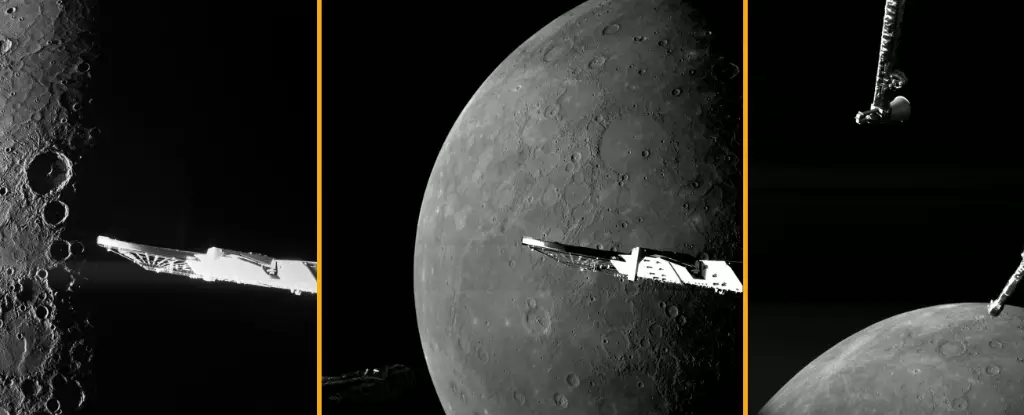The BepiColombo mission, a remarkable endeavor led by the European Space Agency (ESA) in collaboration with the Japan Aerospace Exploration Agency (JAXA), has recently marked a significant milestone with its close flyby of Mercury. Positioned just 295 kilometers above the surface of this enigmatic planet, the transfer probe has captured breathtaking images that reveal the harsh realities of Mercury’s environment. These snapshots not only showcase a world of stark contrasts between shadowy craters and sunlit plains, but they also hint at the fascinating geological and climatic phenomena that have shaped Mercury over time.
Mercury, the innermost planet of our solar system, is a curious study in extremes. With a diameter slightly larger than that of Earth’s Moon, it orbits perilously close to the Sun, at an average distance of approximately 58 million kilometers. This proximity subjects it to relentless solar radiation and the erosive force of solar wind, which together create a minimal atmosphere comprised mainly of transient gases. The planet’s surface experiences dramatic temperature fluctuations, soaring to an oven-like 430 degrees Celsius at midday and plummeting to a frigid minus 180 degrees Celsius in the depths of night.
The lunar-like landscape, punctuated by countless craters, tells a story of relentless bombardment by meteoroids, shaping the planet’s topography over billions of years. Yet, within these craters and shadows, scientists theorize the existence of ice reserves, possibly harboring crucial information about Mercury’s geological past and its potential for future study.
BepiColombo, launched in October 2018, is poised to unravel many of Mercury’s enigmas. The mission’s scientific objectives are clear: to investigate Mercury’s magnetic field, gaseous exosphere, and unique surface features that have perplexed researchers for decades. In the coming weeks, the BepiColombo team will be meticulously analyzing the data gathered during this flyby, which is integral to our understanding of the planet’s evolution. Project Scientist Geraint Jones emphasized that while the main operational phase of the mission is set to commence in 2027, the wealth of information gained through these flybys is invaluable.
Understanding Mercury’s magnetic field is particularly intriguing. The origins of this magnetic phenomenon remain largely unknown, prompting scientists to speculate about the internal processes at work beneath the planet’s surface. Explorations could illuminate whether the magnetic field stems from an active dynamo or other geological activities.
The recent data from BepiColombo also extends our knowledge of Mercury’s geological history. The images captured during this flyby reveal evidence of volcanic activity, as demonstrated by prominent features such as the Nathair Facula, which marks the site of the planet’s largest known volcanic explosion. Additionally, the relatively young Fonteyn crater, formed only 300 million years ago, presents intriguing clues about the timeline of geological events on Mercury.
The upcoming phases of the BepiColombo mission are set to deepen our understanding of this rocky planet. In 2026, the Mercury Transfer Module will return to release the ESA’s Mercury Planetary Orbiter and JAXA’s Mercury Magnetospheric Orbiter. Both orbiters will examine the planet from various altitudes, significantly enhancing the clarity and depth of our understanding of Mercury’s characteristics.
The BepiColombo mission stands as a testament to international collaboration in planetary science, as ESA and JAXA work hand in hand to unlock the mysteries of this challenging environment. As the spacecraft prepares for its primary scientific engagements, the data collected thus far has already begun to reshape our understanding of Mercury’s past and its geophysical processes.
The secrets of Mercury—hidden within its extremes of light and shadow—are gradually emerging through these pioneering explorations. The knowledge gained will not only enrich our comprehension of Mercury as a planetary body but also contribute to the broader understanding of rocky planets within our solar system and beyond. As we look toward the future, the BepiColombo mission promises to provide an unparalleled window into the history and dynamics of one of the most enigmatic planets orbiting our Sun.

